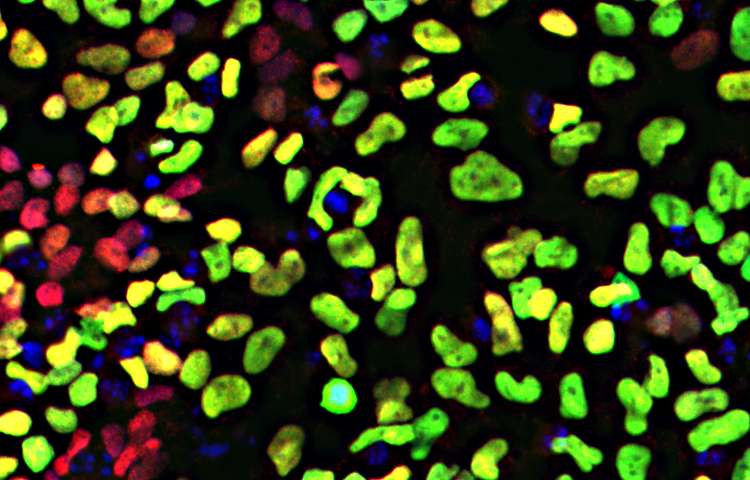Induced human neural crest cells. Human embryonic stem cells display neural crest characteristic expression after only five days of culture under WNT induction. Transcription factors SOX10 and PAX7 are seen in green and red, respectively. Credit: García-Castro lab, UC Riverside.
eural crest cells arise early in the development of vertebrates, migrate extensively through the embryo, and differentiate to give rise to a wide array of diverse derivatives. Their contributions include a large proportion of our peripheral nerves, the melanocytes that provide skin color and protection from damaging UV light, as well as many different cell types in our face, including muscle, bone, cartilage and tooth-forming cells.
The proper functioning of these cells is critical for human development and health. When neural crest biology fails, various birth defects and illnesses - cleft lip/palate, Hirschsprung and Waardenburg syndromes, melanoma and neuroblastoma - result. A better study of these cells is crucial, therefore, to aid in clinical efforts to diagnose and treat such conditions.
But access to these embryonic cells in humans is very difficult. As an alternative, scientists turned to models based in embryonic stem cells.
While protocols to generate human neural crest cells from human embryonic stem cells have progressed since the first report 11 years ago, they still have considerable limitations for their use in basic and clinical research. This is because these protocols commonly use ingredients or components not well defined, such as blood serum which contains many unknown components of varying concentrations. Some protocols result in large clusters of cells, impairing the identification of specific molecules and their roles during neural crest cell formation. Furthermore, the fastest of these protocols takes 12 days (of very costly culture conditions) to convert human embryonic stem cells to neural crest cells. Oftentimes the protocols provide low yields, making the isolation of the desired neural crest cells a time-consuming and technically challenging process.
Work done by a research team led by an associate professor of biomedical sciences in the School of Medicine at the University of California, Riverside now addresses these problems by providing a robust, fast, simple and trackable method to generate neural crest cells. The proposed method can facilitate research in basic sciences and clinical applications alike.
"Our study provides a superb model to generate neural crest cells in just five days starting from human embryonic stem cells or induced pluripotent cells, using a simple and well-defined media with all ingredients known and accounted for," said Martín I. García-Castro, whose lab led the study published in the Feb. 1 issue of the journal Development. "Our cost-effective, efficient and fast protocol allows a better analysis of the relevant signals and molecules involved in the formation of these cells. Our results suggest that human neural crest cells can arise independently from - and prior to - the formation of mesoderm and neural ectoderm derivatives, both of which had been thought to be critical for neural crest formation."

The mesoderm is the middle layer of the embryo in early development. It lies between the endoderm and the ectoderm, with the latter being the outermost layer. García-Castro's previous work on birds already challenged the dogma suggesting that neural crest cells form without mesodermal or neural contribution. Unpublished results from his lab have also confirmed the same using rabbit embryos as a mammalian model.
With regard to identifying specific molecules and their roles during neural crest cell formation, García-Castro's new work demonstrates the critical role played by a molecule known as WNT and highlights contributions from protein families called FGFs and BMPs.
Briefly, WNT proteins are signaling molecules that regulate cell-to-cell interactions during development and adult tissue homeostasis. The FGF protein family controls a wide range of biological functions. BMPs induce the formation of bone and cartilage and form tissues throughout the body.
"Our work provides strong evidence of the critical and initiating role of WNT signals in neural crest cell formation, with later contributions by FGF and BMP pathways," he said.
García-Castro emphasized that the proper function of neural crest cells is essential for human development and health.
"The study of these cells is essential to improve clinical efforts to diagnose, manage, and perhaps prevent diseases and conditions linked to them, and our lab has already launched efforts towards facial clefts - lip and or palate - and melanoma, and we hope to make substantial progress in both areas thanks to this novel protocol," he said.